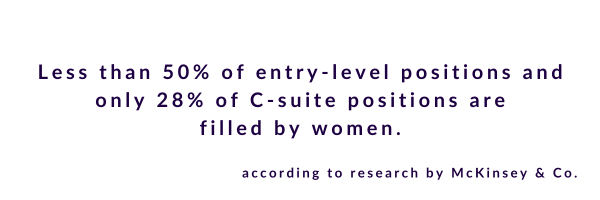How to help women in the workforce build financial security. Learn the different ways female employees struggle with discrimination and financial security along with methods for supporting your workforce.
Women’s equality in the workplace has gradually improved over recent decades — yet despite this progression, female employees still face discrimination and pay disparity that threatens their financial security.
In 2002, women made about $0.80 for each $1 their male counterparts made in 2002, according to Pew Research. Today, over 20 years later, the gender wage gap of about $0.80 on the dollar persists. This makes women in the workplace disproportionately more susceptible to increased financial stress, insecurity and even burnout, compared to their male colleagues.
Learn how financial stress uniquely impacts working women and how firms of all sizes can help their female team members build financial security.

Women are less likely to be promoted, compared to their male counterparts
Across the corporate ladder, women are underrepresented at every rung. Less than 50% of entry-level positions are filled by women, according to research by McKinsey & Co., but only 28% of C-suite positions are filled by women. This speaks to a larger trend: the higher the corporate position, the less female representation within the role.
During promotion cycles, women are less likely to get promoted to a managerial role, compared to their male colleagues. Since women are less likely to get promoted, they are less likely to attain salary increases at the same pace as their male colleagues.
Women with marginalized identities are hit the hardest by financial stress & a lack of financial security
Women are hit hard by financial insecurity — about 25% of women say they’re struggling financially, compared to 18% of men, according to a Mercer report. But, when it comes to financial security and the workplace, not all women have the same experience.
In fact, women with marginalized identities (e.g., LGBTQ+ women, disabled women, women of color) are hit the hardest by financial insecurity — in addition to genderism, their marginalized identities can make it more difficult to attain equitable wages and promotion opportunities.
For instance, for every 100 men promoted to manager, about 89 white women were promoted, 54 Black women and 65 Latinx women, per McKinsey’s report. This shows how the gap in financial security between men and women widens when factoring in marginalized identities, such as race.
Match contributions can help women prepare for retirement & long-term financial security
Across the globe, women are struggling with what’s known as the gender retirement gap — the gap in retirement preparedness between male and female employees.
According to a Prudential Finance survey, when looking at individuals between the ages 55 and 75, women have about a third of the income men have set aside for retirement.
Women tend to have fewer retirement savings than men, largely due to the persisting gender wage gap — by making less money, women have fewer dollars to save for the future.
To help female employees prepare for retirement and increase their financial security, consider offering a match contribution program. For every dollar that an employee saves into their retirement account, employers match (or contribute the same amount). Over time, match programs can help women employees accelerate their retirement savings and build long-term financial security, regardless of where they are in their careers.
Caregiving benefits can help women employees fulfill both professional & personal duties
Today, women are twice as likely to take on unpaid caregiving roles than men, whether it be caring for children or an elderly loved one. For working women, caregiving and household responsibilities are almost like a second job — juggling both can lead to physical, financial and emotional stress.
To support caregivers in the workplace, companies have gradually adopted caregiving benefits, such as hybrid work models, subsidized babysitter costs or discretionary paid time off. Caregiving benefits can help women in the workplace find a better work-life balance, without having to reduce their hours or quit their job altogether.
Looking for a top-notch, mobile-first financial wellness solution? Try Best Money Moves!
Best Money Moves is an AI-driven, mobile-first financial wellness solution designed to help employees with varying levels of financial knowledge dial down their most top-of-mind financial stresses. As an easy-to-use financial well-being solution, Best Money Moves offers comprehensive support toward any money-related goal, ranging from debt management to purchasing a home. With 1:1 money coaching, budgeting tools and other resources, our AI-driven platform is designed to help bolster employee financial wellbeing.
To learn more about Best Money Moves Financial Wellness Platform, let’s schedule a call. Contact us and we’ll reach out to you soon.





